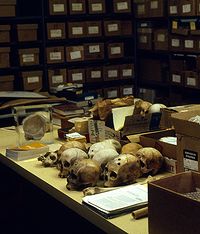
Content created: 2010-09-09
File last modified:
This page links to very brief summary data on the hominid fossils most likely to be of importance in any introductory world-civ or general anthropology course involving a small amount of human paleontology. The present section is designed only as a clarifying overview of specific fossil forms. For useful general discussion of the development of our understanding of human evolution and the implications for the human career, see Quick Essays on Evolution; the essays deal with higher-level issues rather than specific fossil forms.
For the most part, each species is on a separate page and includes a picture of a cast of a skull and, where available, a drawing or a picture of a waxwork reconstruction.
Some scholars differentiate a subfamily called homininae ("hominines" or "hominins") to refer to these specimens, reserving the family name hominidae ("hominids") for broader range of species than previously, including chimps and gorillas. Since all hominin(e)s are hominids anyway, that term is ignored here. (Click here for a table showing the organization of classification categories.)
A very brief glossary linked to the top of each page opens in secondary window. Except on this page, terms found in the glossary are underlined with small blue dots. They are not links —the link to the glossary is at the top of each page— but a brief definition will appear if you hold your mouse over them.

Two review quizzes are available for this material, Normal and Hero.
Students in MMW-11 are invited to use additional materials on a password-restricted page, Developments in Hominid Paleontology.
This set of materials takes its inspiration from a "Hominid Guide" devised by Dr. Nancy J. Friedlander in 1990 for use in the first quarter of "Making of the Modern World," a world-civilization sequence in Eleanor Roosevelt College, UCSD. The present text is differently organized, newer, and much shorter. I have also added pictures. But the goal of an easily accessible, reasonably masterable introductory overview of the hominid fossil record for the convenience of beginning college students remains. I am most grateful for Dr. Friedlander's advice and assistance as I have sought to take account of changing information and new interpretive trends.